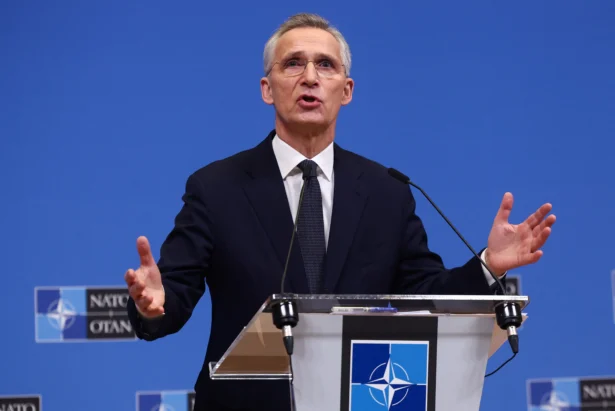U.S. Secretary of State Antony Blinken signaled on Friday that President Joe Biden’s administration has ratcheted forward support for Ukrainian military activity to deal with threats inside Russia’s borders, but offered few specifics about the changing rules of engagement.
Throughout the more than two years of large-scale fighting between Ukrainian and Russian forces, the Biden administration and other leaders of the North Atlantic Treaty Organization (NATO) countries have gradually provided the Ukrainian side with more advanced and longer-ranged weapons systems, gradually considering and then reconsidering how much they can help the Ukrainians without escalating into an open conflict between NATO and a nuclear-armed Russia.
Until recently, NATO members have maintained a relative ban on Ukrainian forces using their donated weapons to strike across their eastern border into Russia’s internationally recognized territory. Those views have begun to shift amid a renewed Russian offensive in the Ukrainian border region of Kharkiv. Ukrainian President Volodymyr Zelenskyy has increasingly asked his NATO backers to loosen the rules of engagement to allow his forces to strike inside Russia, and, in recent days, several leaders within the Western alliance have begun to relent.
Mr. Blinken was asked to address the Biden administration’s policy toward Ukrainian striking targets inside Russia’s borders with U.S.-donated weapons at a press conference during his visit to the Czech Republic on Friday. Mr. Blinken’s comments to reporters indicate the Biden administration is also beginning to loosen its restrictions on how Ukrainian forces fight, but he kept the details sparse.
Without laying out exactly when and how Ukrainian forces can use U.S.-donated weapons against Russian forces, Mr. Blinken announced that the Biden administration’s policy toward the Ukrainian use of U.S.-donated weapons has recently changed.
“Over the past few weeks, Ukraine came to us and asked for the authorization to use weapons that we’re providing to defend against this aggression, including against Russian forces that are massing on the Russian side of the border and then attacking into Ukraine,” Mr. Blinken told reporters. “And that went right to the president, and as you heard, he’s approved the use of our weapons for that purpose.”
NTD News has repeatedly reached out to Biden administration components in recent days for clarity about its policies toward Ukraine’s use of U.S.-donated weapons to strike Russian territory.
In an emailed response on Friday, the U.S. State Department told NTD News, “The President recently directed his team to ensure that Ukraine is able to use U.S.-supplied weapons for counter-fire purposes in the Kharkiv region so Ukraine can hit back against Russian forces that are attacking them or preparing to attack them.”

The emailed State Department statement went on to say that the Biden administration’s policy prohibiting Ukrainian forces from using a U.S.-donated tactical ballistic missile platform known as the Army Tactical Missile System (ATACMS) and other “long-range strikes” inside of Russia “has not changed.”
NTD News followed up requesting further clarification about what types of weapons Ukrainian forces could use to strike inside Russia, if not ATACMS and other “long-range strikes,” but the State Department did not respond with additional details.
How Other Nations See Strikes on Russia
Other NATO leaders have laid out their position on Ukraine striking inside Russia’s borders more explicitly. On Monday, NATO Secretary General Jens Stoltenberg said Ukraine’s right to self-defense “includes the right to also attack legitimate military targets inside Russia.” French President Emmanuel Macron also said on Wednesday that he believes Ukrainian forces should be able to strike missile launch sites within Russia’s borders that are firing missiles into Ukraine, but not other targets inside Russia’s borders.

Last weekend, Swedish Defense Minister Pål Jonson also told the Swedish newspaper Hallandsposten that “Ukraine has the right to defend itself through combat actions directed at the opponent’s territory as long as the combat actions comply with the laws of war.”
Still, some leaders among the NATO countries have opposed signing off on Ukrainian strikes inside Russian territory.
Speaking to Italy’s Ansa News agency on Monday, Italian Prime Minister Giorgia Meloni distanced herself from Mr. Stoltengberg’s comments about such attacks on Russia and said the NATO official should exercise “more prudence.” Deputy Italian Prime Minister Matteo Salvini also told Ansa News that Mr. Stoltenberg’s comments raise the prospect of a new world war and that the NATO secretary general should apologize for his recent remarks or resign.
Hungarian Prime Minister Viktor Orban also argued during a Friday news interview that comments by his fellow NATO counterparts endorsing Ukrainian strikes inside Russia are risky and bring the alliance closer to direct conflict with Russia.
Russian President Vladimir Putin offered his own pushback on talks of Ukrainian strikes inside Russia at a press conference while visiting Uzbekistan on Tuesday, stating NATO member nations “should be fully aware of what is at stake,” adding “theirs are small and densely populated countries, which is a factor to reckon with before they start talking about striking deep into the Russian territory.”
